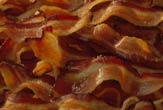Don't Bring Home the Bacon, Print It

Ink-jet printing has come a long way; we used to use it for what was called "hard copy." Soon, you will be able to use a modified ink-jet printer to make yourself some breakfast.
Tissue engineers like Vladimir Mironov of the Medical University of South Carolina, and Thomas Boland of Clemson University, have been printing biomaterials with modified ink-jet printers.
The cartridges are washed out and refilled with suspensions of living cells; the software that controls the characteristics of the ink is reprogrammed and you're good to go. Boland and Mironov use layers of "thermo-reversable" gel to build up three-dimensional structures like tubes—capillaries, to use the medical term. When the tiny droplets, or clumps, of cells came together closely, they fused; the gel can be easily removed, leaving a tube of tissue.
Just as printers contain inks of different colors, so tissue printers could contain different cell types to create complex structures.
Now, it seems to me that a tube or complex living organ is a pretty complicated structure. Why not practice with a simpler, more two-dimensional form of muscle tissue—like bacon, for instance? Nothing like fresh bacon.
Artificially cultivated meat is a USDA-certified science-fictional idea. In his slightly creepy 1969 novel Whipping Star, science fiction phenomenon Frank Herbert wrote about pseudoflesh,meat protein that was produced apart from an animal:
"Where would they get a real steer?" "There are some around for story props in the various entertainment media, that sort of thing. A few of the outback planets where they haven't the technology for pseudoflesh still raise cattle for food." (Read more about Frank Herbert's pseudoflesh)
Take a look at Cultured Meat Straight From The Vat for yet another promising technology. See also Replacement organs hot off the press.
Sign up for the Live Science daily newsletter now
Get the world’s most fascinating discoveries delivered straight to your inbox.
(This Science Fiction in the News story used with permission from Technovelgy.com - where science meets fiction.)









